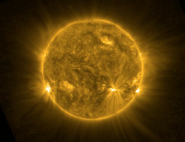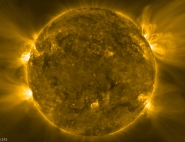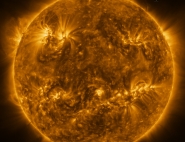SO/PHI Instrument
The Polarimetric and Helioseismic Imager (PHI) will provide high-resolution and full-disk measurements of the photospheric vector magnetic field and line-of-sight (LOS) velocity, as well as the continuum intensity in the visible wavelength range at a cadence of one set of observables per minute. The LOS velocity maps will have the accuracy and stability to allow detailed helioseismic investigations of the solar interior, in particular of the solar convection zone.
The PHI instrument consists of two telescopes, a High Resolution Telescope (HRT) that will image a fraction of the solar disk at a resolution reaching ~150 km at perihelion, and a Full Disk Telescope (FDT) to image the full solar disk at all phases of the orbit. PHI will carry out measurements with a narrow band filtergraph at several wavelength positions in a Zeeman-sensitive photospheric spectral line, and in the nearby continuum. At each spectral position, the polarization state of the incoming light will be analyzed.
From the observables (the four Stokes parameters that fully describe an electromagnetic wave), a number of solar physical quantities will be retrieved: the LOS flow velocity (vLOS) and the three components of the vector magnetic field (field strength, inclination, and azimuth). From these quantities, the LOS component and the transverse component of the magnetic field vector (BLOS and BTrans) can be derived. Together with the continuum intensity Ic (a proxy for the plasma temperature, which also provides the image context for the other variables), spatial maps of these variables constitute the main data products of the instrument.
The off-axis Ritchey-Chrétien HRT will image a fraction of the solar disk at a resolution reaching ~150 km at minimum perihelion distance (0.23 AU). The FDT provides a FOV of 2.6° with a pixel size of ~730 km (at 0.23 AU), giving a complete view of the solar disk during all orbital phases. An off-pointing mechanism allows the FDT to continue observing the whole solar disk while the spacecraft, including the HRT, is pointing off the solar disk centre. Continuous observations of the full solar disk by the FDT are needed to allow precise sensing of the solar limb and provide stable pointing. PHI will have its own image stabilization system (ISS) that compensates spacecraft jitter and other disturbances. This system is composed of a limb sensor and separate rapid tip-tilt mirrors for the FDT and the HRT.
In order to limit the amount of light entering the instrument, two entrance windows, one for each telescope, are mounted on the spacecraft's heat shield. These windows act as heat rejection filters with a transmission band of about 30 nm width centred on the science wavelength, such that the total transmittance does not exceed 4% of the total incident energy. The feasibility of such a filter has been demonstrated during the ESA Technology Development Activity (TDA).
Each telescope has its own polarization modulation package (PMP), located early in the optical path to minimize polarization cross-talk effects. Each PMP consists of two liquid crystal variable retarders (LCVRs) followed by a linear polarizer. Spectral analysis is performed by a Fabry Perot filtergraph system (FG) consisting of two lithium niobate (LiNbO3) etalons which extract a spectral portion of the FeI 6173 Å absorption line and at a nearby continuum point. The FG provides a tuning range of ±0.6 Å, which is required for compensating the spacecraft radial velocity of ±30 km/s plus the range required to scan the spectral line (~400 mÅ, depending on the observing mode).
A digital processing unit (DPU) performs image accumulation, pre-processing, and calculation of physical variables (Stokes inversion and data compression), and controls the instrument interfaces with the spacecraft.


